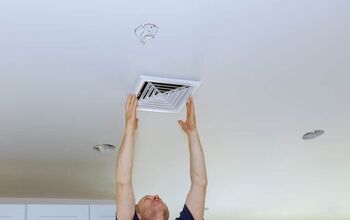Why Is My House Cold Even With The Heat On?

It’s natural to reach for the thermostat during the fall and winter. Of course, you expect your home to heat up, but that doesn’t always happen. So, why is my house cold even with the heat on?
Check your air ducts and insulation for leaks if your house is cold even with the heat on. Your house can also fail to heat up if your doors and windows have cracks, so you must seal them. If parts of your house are cold and others are warm, it could be because you don’t have a zoned heating system.
Furnaces only typically last 15-20 years, so it may be time to replace yours. Follow along as we explore why your house is cold even with the heat on, and see how to fix it.
Why Is My House Cold Even With The Heating On?
Between leaky air ducts, blocked vents, and poor insulation, there are several reasons why your house is cold even with the heating on. Luckily, most of these causes have simple solutions that will make your house warm in no time.
1. Duct Work Leaks
If your house is cold even with the heat on, it may have nothing to do with your furnace. In many cases, it’s simply a problem with your duct work. Your duct work carries the air throughout your home to warm and cool it.
Old duct systems are susceptible to cracks and wedges that make the air leak out before it can reach a vent. Your house won’t get warm, but you’ll still pay the cost to run your furnace. Unfortunately, it can cost up to $500 to fix duct work leaks.
You will quickly notice that your house heats up when you adjust the thermostat. It will also save you money each month, since you won’t have to run the furnace higher than necessary.
2. Gaps In Insulation
Your house won’t stay warm even with heat on if drafts come in. Gaps in your insulation will let cold air in, and let warm air out. Not only does this make your home uncomfortable, but it can also increase your heating bills each month.
Luckily, it’s easy to fill the gaps in your insulation once you locate them. You can find insulation-gap foam sealer spray for $6-$10 per bottle. Simply find the gaps and spray the foam as directed on the bottle.
However, you may need to contact a professional if the insulation gaps are widespread and hard to reach. It’ll be worth the cost when you save money on your heating bill each month.
3. Dirty Air Filters
Your home’s air filters aren’t just necessary for cooling; they are essential for heating, too. It doesn’t take long for air filters to get clogged with the dust and debris that circulates throughout your home. The average homeowner must replace the air filter every 3 months.
That said, it’s important to check your air filter sooner if you notice your HVAC system isn’t working properly. It’s time to replace your filter if it’s dirty or you can’t see through it. Warm air won’t be able to pass through your ducts and heat your home.
Ideally, you should always keep 2-3 spare air filters in a closet for emergencies. You can easily replace your filter yourself without an HVAC professional, and your house should heat up in no time.
4. The Air Is Too Dry
Even if your air ducts and furnace are fine, your house can still run cold if the humidity level is off. The more you run your furnace, the less humid your home will be. Furnaces often pull cold air from outside, and cold air is quite dry.
Your house will likely feel cold even with the heat on if the humidity level drops below 30%. Luckily, humidifiers are cheap, and you can find nice ones for just $40. High-end humidifiers cost up to $200, but that may be unnecessary if your house isn’t too large.
Instead, simply put a few small, inexpensive humidifiers in a couple of areas in your home. Try to keep the humidity level in your home around 45% during the winter when you run the furnace a lot. Some homeowners set the humidity level to 50% but beware that your house can get muggy.
5. Blocked Vents
Have you checked your vents since you noticed it was cold even with the heat on? It’s a simple fix to open your vents. Many homeowners close their vents and forget about them.
Most vents have a small lever you can push to the side to open or close them. Open your vents, wait a few minutes, and see if your house heats up.
6. Faulty Furnace
Depending on how old your furnace is, you may need to replace it. This is the last thing most homeowners want to hear, but it’s necessary if the furnace doesn’t work. Furnaces can last up to 20 years, but they typically only thrive for 15 years.
They can stop working sooner than that due to short circuits and internal damage. It costs up to $8,000 to replace a furnace, but you can spend $3,500 or less. The cost depends on the type and brand of furnace.
Gas furnaces typically provide better heat, but electric furnaces are more efficient. Many electric furnaces have also recently become cheaper than gas furnaces.
7. Gaps In Doors And Windows
Your doors and windows stop warm air from escaping your house when you run the furnace. That is unless they have cracks and gaps. Even a tiny gap under your front or back door can let cool air in and warm air out.
What you can do is put some weatherstripping at the bottom of any entrance door with a gap. This will save you money on your energy bills because the warm air will stay inside. You won’t have to turn up the furnace as much if cold air stays out of the house.
Cracks in your window and worn caulking can also have the same effect. It’s quite easy to patch the caulking on your windows, and you won’t need professional help. However, you may want to call a professional if the window’s glass is cracked. It must be replaced altogether at that point.
8. You Don’t Have Zoned Heating
Are some parts of your house warm and the others are cold? This could be because of an insulation problem, but it could also be because of your HVAC system. Zoned heating systems heat several areas of your house, so the air feels consistently warm.
Not every home has zoned heating, however, and that may be why your house is cold even with the heat on. This happens in a lot of older two-story homes. Zoned HVAC systems start at $1,500, but they can cost up to $9,000.
The cost varies based on the brand, size of your home, and labor for the installation. Luckily, you can also add zones to many HVAC systems if you don’t want to replace the system altogether. This is much cheaper in most cases and costs between $1,500 and $4,500.
How High Should You Set Your Thermostat In The Winter?
Ideally, you should set your thermostat to 68 or 69 degrees Fahrenheit throughout winter. You may have to turn it up on particularly cold days. However, your energy bills will be much higher if you regularly keep your thermostat at 70-72 degrees or more for long periods.
Summing It Up
Your house will be cold even with the heat on if your duct work leaks. This can also happen if the humidity level is under 30% and if your air filter is clogged. Make sure the vents are open and check your entry doors and windows for cracks and gaps. It’s worth the cost to upgrade to a zoned heating system if some parts of your house are cold and others are warm.
Related Guides:

Nick Durante is a professional writer with a primary focus on home improvement. When he is not writing about home improvement or taking on projects around the house, he likes to read and create art. He is always looking towards the newest trends in home improvement.
More by Nick Durante













![The 5 Best Angle Grinders – [2022 Reviews & Buyer's Guide]](https://cdn-fastly.upgradedhome.com/media/2023/07/31/9071326/the-5-best-angle-grinders-2022-reviews-buyer-s-guide.jpg?size=350x220)













